Red light therapy harnesses specific wavelengths to activate your body's natural anti-aging mechanisms at the cellular level. Your skin cells' mitochondria absorb this light, boosting ATP production and enhancing their ability to repair damage and produce collagen. You'll notice improved skin elasticity, reduced fine lines, and enhanced blood circulation as the therapy stimulates fibroblast growth and promotes new blood vessel formation. When used daily, this non-invasive treatment works beneath the surface to rejuvenate skin cells, repair DNA damage, and combat inflammation. Understanding the ideal wavelengths and treatment protocols can maximize your anti-aging results.
The Science Behind Red Light
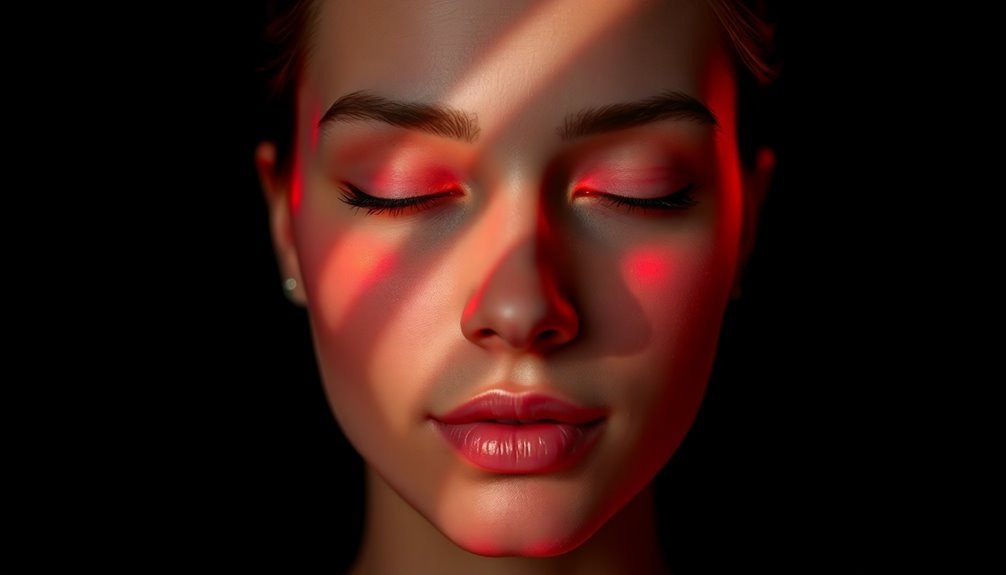
The remarkable science behind red light therapy stems from its unique ability to penetrate deep into your skin's layers, where it interacts directly with cellular mitochondria.
When your cells absorb this therapeutic wavelength, it triggers a cascade of biological processes that rejuvenate your skin from within. The red light waves boost ATP production in your cells for enhanced energy and repair.
You'll experience increased collagen production, which naturally enhances your skin's elasticity and reduces the appearance of fine lines. The light stimulates fibroblasts, specialized cells that play a vital role in tissue repair and maintaining skin structure.
It's not just about surface-level changes – red light therapy promotes angiogenesis, forming new blood vessels that improve circulation and nutrient delivery to your skin cells.
NASA's research has validated these effects, showing that high-intensity red LEDs substantially accelerate healing processes. Studies demonstrate up to 40% greater improvement in tissue repair, while clinical evidence points to a 50% faster healing time for wounds.
Your skin's natural rejuvenation process gets supercharged as the light activates cellular repair mechanisms, though you'll need proper eye protection during treatments to safeguard safety.
This scientifically-backed approach offers a non-invasive way to combat aging at the cellular level.
Cellular Repair Mechanisms
Your cells' repair mechanisms kick into high gear when you combine red light therapy with proper cellular maintenance, boosting mitochondrial energy production and activating essential DNA repair processes.
The therapy triggers fibroblasts, specialized cells that produce collagen and elastin, to work more efficiently in repairing and maintaining your skin's structural integrity.
These repair mechanisms work synergistically to combat aging at the cellular level, utilizing your body's natural DNA repair pathways while stimulating the production of ATP, your cells' primary energy source. This cellular restoration process becomes increasingly vital as DNA repair capacity declines with age, making proactive maintenance essential for optimal cellular health.
Mitochondrial Energy Production Boost
Located at the heart of cellular aging, mitochondrial function plays a pivotal role in determining how well your body ages and repairs itself. Your mitochondria's ability to efficiently convert energy directly impacts your cellular health and longevity, making it essential to enhance their performance.
You can boost your mitochondrial energy production through several targeted strategies. Adopting intermittent fasting enhances mitochondrial biogenesis and improves your metabolic flexibility. A diet rich in antioxidant-rich foods helps protect mitochondria from damaging reactive oxygen species.
When you combine this with regular exercise, you'll stimulate the creation of new mitochondria through increased PGC-1α and AMPK activation.
Supporting your gut health is equally important, as a healthy microbiome produces short-chain fatty acids that enhance mitochondrial function. You'll want to focus on reducing oxidative stress through proper nutrition and lifestyle changes to protect your mitochondria from damage.
Your mitochondria's electron transport chain produces over 30 ATP molecules per cycle, but this efficiency can decline with age. By implementing these strategies, you're helping maintain ideal cellular conditions and energy production.
Skin Cell DNA Repair
While your skin constantly battles environmental damage, its DNA repair mechanisms work tirelessly to maintain cellular integrity and prevent premature aging. Your cells employ sophisticated repair systems, particularly when dealing with UV-induced damage that creates pyrimidine dimers in your DNA structure. Base excision repair efficiently removes and replaces individual damaged bases to maintain DNA integrity.
You'll find two primary repair mechanisms at work: photoreactivation, which uses visible light to break harmful DNA bonds, and nucleotide-excision repair, where specialized proteins recognize and remove damaged DNA segments.
Your skin's repair capacity naturally declines with age, but you can support these processes through targeted interventions.
To enhance your skin's DNA repair capabilities, you'll want to focus on maintaining adequate NAD levels, which play a vital role in protein interactions during DNA repair. You can also protect your repair mechanisms by limiting UV exposure and supporting stem cell function, which helps regenerate damaged tissue.
Consider incorporating chemical exfoliants like AHAs and BHAs into your skincare routine to promote healthy cell turnover, giving your repair mechanisms the best chance to function effectively. This thorough approach helps prevent accumulated DNA damage that can lead to premature aging and increased cancer risk.
Fibroblast Activation Process
Fibroblasts serve as the skin's primary repair factories, orchestrating cellular regeneration through collagen and elastin production. When you understand how these cells work, you'll realize they're essential for maintaining your skin's firmness and elasticity. Hyaluronan production by fibroblasts creates a vital scaffold for tissue structure and repair.
As your fibroblasts become activated, they launch into a precise repair sequence, producing the key proteins your skin needs to stay youthful and resilient.
Your skin's repair process relies heavily on fibroblast activation. These cells respond to micro-injuries by increasing collagen synthesis and tissue remodeling, which helps your skin bounce back from damage. You'll find this principle at work in treatments like plasma fibroblast therapy, where controlled micro-injuries stimulate your fibroblasts to regenerate tissue and tighten skin.
However, your fibroblasts' efficiency decreases with age, leading to reduced collagen and elastin production. That's why targeting fibroblast activation becomes important in anti-aging protocols. Modern treatments focus on FAP (Fibroblast Activation Protein) to enhance cellular repair mechanisms. By supporting your fibroblasts' natural functions, you're helping maintain your skin's structural integrity and promoting its ability to repair and regenerate.
Collagen Production Breakthrough
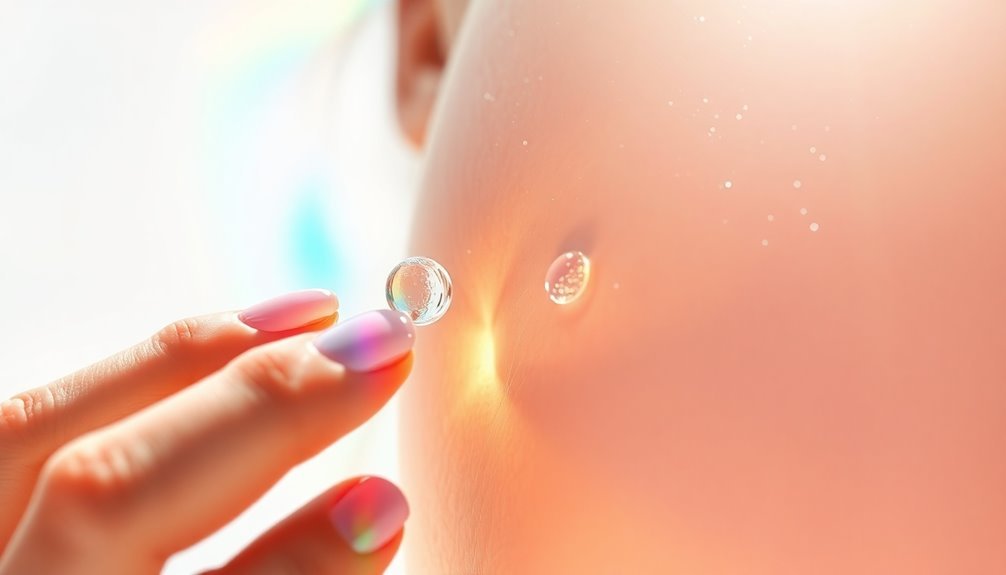
Science's latest breakthrough in collagen production has revolutionized our understanding of skin rejuvenation. You'll now find powerful treatments that work at both cellular and extracellular levels to boost your body's natural collagen synthesis. From intracellular processes to post-translational modifications, each step has been optimized for maximum effectiveness. These treatments consistently deliver growth factors and cytokines through exosome technology to enhance cellular communication and repair.
You've got multiple options to stimulate your collagen production effectively. Microneedling creates controlled micro-injuries that trigger your skin's natural healing response, while radiofrequency treatments deliver precise energy to activate deeper skin layers.
If you're looking for injectable solutions, Sculptra works by stimulating your fibroblasts to produce more collagen naturally.
The market's also embracing innovative approaches like exosome-based treatments, which harness stem cell-derived growth factors to enhance collagen production. You'll see results not just in your skin's appearance but also in stronger bones, healthier hair, and more resilient nails.
With the collagen market projected to reach $22.7 billion by 2032, you can expect even more breakthrough treatments combining hyaluronic acid injections and advanced collagen stimulants to emerge, offering you longer-lasting results in your anti-aging journey.
Daily Treatment Schedule
Your timing of red light therapy sessions can substantially impact their effectiveness, with morning treatments energizing your skin for the day ahead and evening sessions promoting overnight recovery.
You'll want to maintain consistent 10-20 minute sessions, whether you choose morning or evening treatments, to maximize collagen production and skin repair benefits.
While both timeframes offer advantages, evening sessions often work best for most people since they allow uninterrupted healing time during sleep. Using red light therapy in the evening can help balance serotonin levels and contribute to more restful sleep.
Morning Vs Evening Sessions
Deciding between morning and evening red light therapy sessions boils down to more than just personal preference.
Morning sessions align with your body's natural ATP production peaks between 8 AM and 11 AM, while evening sessions can enhance melatonin production and improve sleep quality. Clinical studies have shown that LED light treatments effectively boost cellular rejuvenation and repair processes during these peak times.
Your morning treatments can take advantage of your cells' natural attunement to red and near-infrared wavelengths, potentially enhancing biological processes and cognitive function. If you're an early riser, you'll find it easier to incorporate these sessions into your regular routine without disrupting your sleep patterns.
Evening sessions, however, offer unique benefits by simulating sunset and helping regulate your circadian rhythm. You'll want to time these sessions carefully – a 30-minute exposure can boost melatonin production, but overexposure to bright light at night might be overstimulating.
What's most essential isn't whether you choose morning or evening – it's maintaining consistency. Studies show comparable efficacy between both times, so select the schedule that you can stick to reliably.
Whether you opt for 10-20 minute sessions in the morning or evening, focus on maintaining regular exposure using wavelengths between 630-1000nm for ideal anti-aging results.
Optimal Treatment Duration
The ideal duration for red light therapy follows a precise schedule to maximize its anti-aging benefits. You'll want to schedule your sessions to last between 10 to 20 minutes, keeping them short but consistent.
For best results, you can safely perform up to three treatments daily on each target area, verifying at least 7 hours between sessions. Similar to medication timing guidelines, you can follow a TID schedule pattern by spacing treatments at roughly even intervals while awake.
Your treatment protocol should span 4 to 6 weeks with 3 to 4 sessions per week, followed by maintenance sessions once or twice weekly. To achieve the best anti-aging results, follow these key guidelines:
- Start with a single daily session to observe how your skin responds, then gradually increase to multiple sessions if desired
- Space out your treatments throughout the day, similar to a medication schedule, to maintain consistent light exposure
- Keep your sessions within the recommended timeframe – more isn't always better
Remember that consistency matters more than session length. The therapeutic benefits come from regular exposure to the right power density (10-200mW/cm²), rather than extended treatment times.
Optimal Wavelength Selection
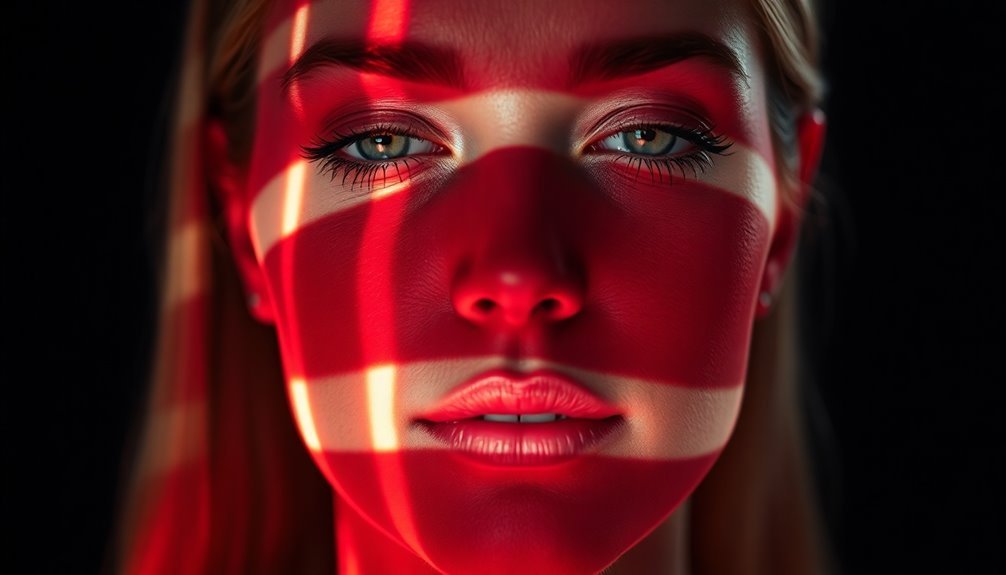
Selecting from among the most effective wavelengths stands as a pivotal first step in any anti-aging light therapy protocol.
For the best anti-aging results, you'll want to focus on wavelengths between 630nm and 670nm in the red light spectrum, as these specifically target collagen and elastin production in your skin's surface layers. The therapeutic process requires a proper power density to achieve visible results.
You'll achieve even better results by combining red light with near-infrared (NIR) wavelengths of 810nm, 830nm, and 850nm. This combination penetrates deeper into your tissues, addressing both surface-level concerns and underlying structural issues. The red light works on immediate skin texture and tone, while NIR tackles deeper tissue healing and inflammation reduction.
For your daily protocol, you'll benefit most from devices that offer both ranges. Look for systems that deliver wavelengths around 660nm for surface-level rejuvenation and 850nm for deep tissue repair.
You'll want to use these in combination 3-4 times weekly for the first 4-6 weeks, then reduce to 1-2 maintenance sessions weekly. This frequency guarantees consistent cellular regeneration while preventing overexposure.
Professional Versus Home Devices
Understanding the stark differences between professional and home devices proves crucial for your anti-aging light therapy journey. While home devices offer convenience, they can't match the power and precision of professional equipment.
Professional devices deliver higher energy levels and more effective treatments, particularly when targeting larger areas of your body like legs or back.
When you opt for professional treatments, you'll benefit from expert oversight and precise parameter adjustments. Trained professionals can maximize your results while ensuring your safety through:
- Real-time treatment modifications based on your skin's response
- Strategic targeting of specific areas with ideal power settings
- Extensive coverage of larger treatment zones in fewer sessions
Your at-home device serves well for maintenance and minor treatments, but it's limited by lower power settings and smaller treatment areas. Professional devices, equipped with advanced technology and higher power output, deliver superior collagen enhancement and more effective healing.
They're particularly advantageous when you're seeking dramatic anti-aging results or treating extensive areas. The combination of clinical expertise, precise energy delivery, and sophisticated technology makes professional treatments substantially more effective for achieving your anti-aging goals.
Protective Measures During Treatment
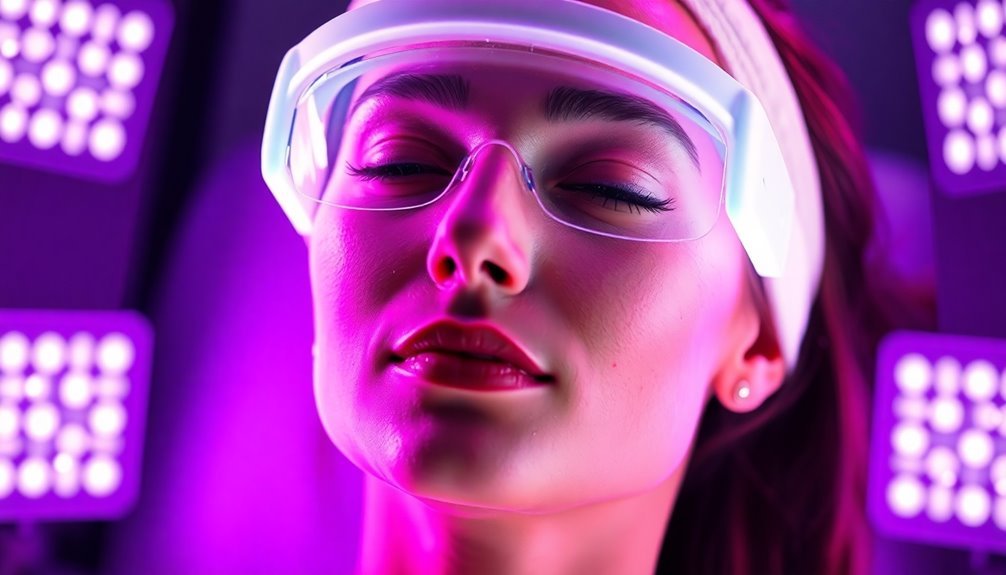
You'll need proper eye protection during anti-aging light treatments to prevent potential damage, especially if you're sensitive to bright light or have pre-existing eye conditions.
Your skin temperature shouldn't exceed a comfortable warmth during treatment, and you should stop immediately if you experience any burning sensations or excessive heat.
It's essential to monitor both your eye comfort and skin temperature throughout each session, adjusting the treatment intensity or duration if needed.
Eye Protection Essentials
The safety of your eyes during anti-aging treatments requires specific protective measures, especially when using red light therapy or cosmetic lasers. While wavelengths between 630-850nm are generally considered safe, you'll still need proper eye protection when using these devices at close range or for extended periods.
Standard sunglasses won't provide adequate protection during red light therapy sessions. Instead, you'll need specialized blackout goggles or FDA-approved light therapy eyewear. These are designed to effectively block red and NIR rays, ensuring your eyes remain protected throughout the treatment.
For your anti-aging protocol, remember these essential eye protection guidelines:
- Use specialized protective goggles that match your treatment type – regular goggles for red light therapy or specific laser safety glasses for cosmetic laser procedures
- Keep your eyes protected even when they're closed, as eyelids are thin enough for light penetration
- Choose protective eyewear based on the wavelengths you're using – different treatments require different types of protection
When treating the eye area specifically, you can still benefit from red light therapy through closed eyelids, but always maintain proper distance and timing according to your device's instructions.
Skin Temperature Guidelines
Beyond protecting your eyes, maintaining proper skin temperature during anti-aging treatments plays a vital role in both safety and effectiveness. You'll need to monitor your skin temperature carefully, as exceeding 43°C can cause damage, while temperatures too low might reduce therapeutic benefits.
| Temperature Range | Purpose | Safety Measure |
|---|---|---|
| 37°C – 43°C | Hot therapy applications | Monitor every 2-3 minutes |
| 12°C – 15°C | Cold therapy applications | Check skin response regularly |
| 20°C – 25°C | Ambient room temperature | Maintain controlled environment |
When you're using contrast treatments like CWT, you'll want to follow specific protocols for ideal results. The recommended 4:1 ratio of hot-to-cold exposure helps maintain safe skin temperatures while maximizing therapeutic benefits. If you're starting with warm applications (Protocol A), you'll notice your skin temperature gradually adjusts during treatment intervals. For cold starts (Protocol B), your body's response pattern differs, but both approaches require careful monitoring.
Remember to keep track of ambient temperature and humidity levels during your treatments, as these factors can affect your skin's response. You'll need to adjust treatment duration and intensity based on your skin's temperature fluctuations to guarantee both safety and effectiveness.
Combining Therapies for Maximum Results
Modern anti-aging protocols have evolved beyond single-treatment approaches, demonstrating that combining therapies delivers superior results. When you combine red light therapy with other treatments, you'll maximize the benefits for your skin while addressing multiple concerns simultaneously.
The key lies in using specific wavelengths (630-670nm and 830-855nm) alongside complementary treatments like chemical peels or DiamondGlow sessions.
You'll achieve the most dramatic improvements by following these evidence-based combinations:
- Integrate red light therapy with near-infrared light to boost collagen production and enhance skin barrier recovery
- Pair deep exfoliation treatments with red light sessions to accelerate cellular repair and reduce inflammation
- Schedule regular maintenance sessions that combine different wavelengths to target both surface-level and deep tissue concerns
Your skin will benefit from the synergistic effects of combined therapies, as they work together to stimulate cellular energy production, repair damaged tissues, and promote long-term skin health.
Tracking Your Progress
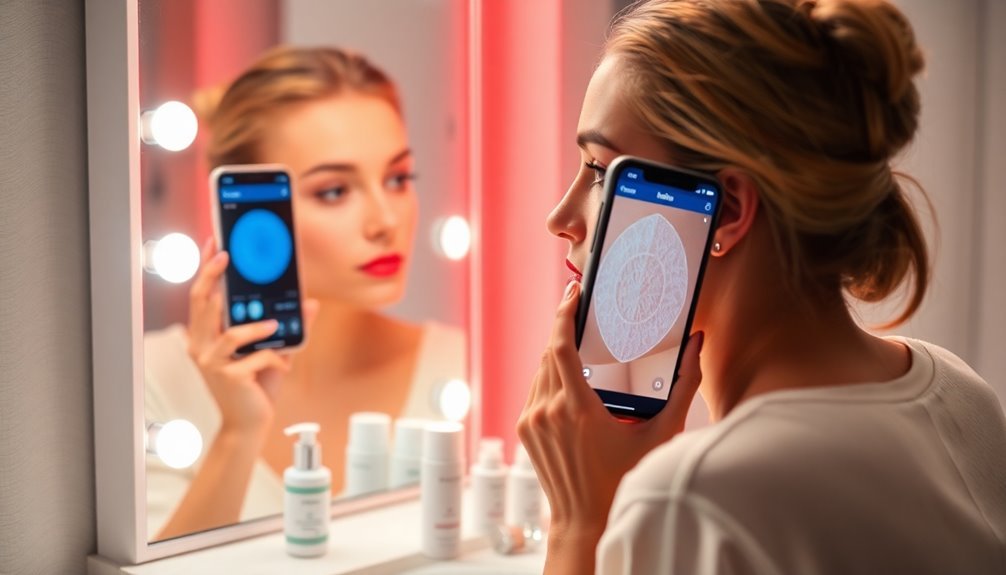
Scientific progress tracking forms the cornerstone of any effective anti-aging protocol. You'll need to combine both objective measurements and subjective observations to get a complete picture of your anti-aging journey.
The DunedinPACE algorithm can help you track DNA methylation patterns, while regular blood tests can monitor essential biomarkers like TIMP2 levels in your plasma.
You shouldn't rely solely on visible changes, as aging occurs at different rates across your organs. Instead, maintain detailed records of multiple indicators.
Track your skin's response to red light therapy, noting improvements in barrier recovery and collagen production. Use standardized questionnaires and Likert scales to evaluate treatment effectiveness, and keep a log of your personal observations.
Consider working with healthcare professionals who can provide clinical assessments and adjust your protocol based on biological age markers. They'll help you interpret complex data and make informed decisions about your treatment plan.
While cosmetic improvements are important – with only 29% of users reporting significant results – focus on thorough tracking methods that capture both visible and internal changes. This multi-faceted approach will give you the most accurate assessment of your anti-aging protocol's effectiveness.
Common Treatment Mistakes
Four critical mistakes can derail your anti-aging protocol, potentially accelerating rather than slowing the aging process. One of the most damaging errors is overexfoliation, which strips your skin's natural oils and damages its protective barrier, leading to premature aging and dullness.
You'll also find that misapplying products, especially sunscreen, can result in uneven aging signs and inadequate protection.
The most common treatment mistakes include:
- Not applying broad-spectrum SPF 30+ sunscreen daily to all exposed areas, including neck and hands
- Overusing harsh exfoliants without understanding the difference between physical and chemical methods
- Falling for unregulated or ineffective treatments that waste money and potentially harm your skin
Your skin's health depends on proper knowledge and protection. Without understanding the role of collagen, elastin, and antioxidants, you might unknowingly compromise your skin's integrity.
Remember that UV exposure accounts for 80% of facial aging, making daily sun protection vital. Don't underestimate the importance of protective clothing and accessories like wide-brimmed hats and sunglasses in your anti-aging strategy.
Long-Term Maintenance Protocol
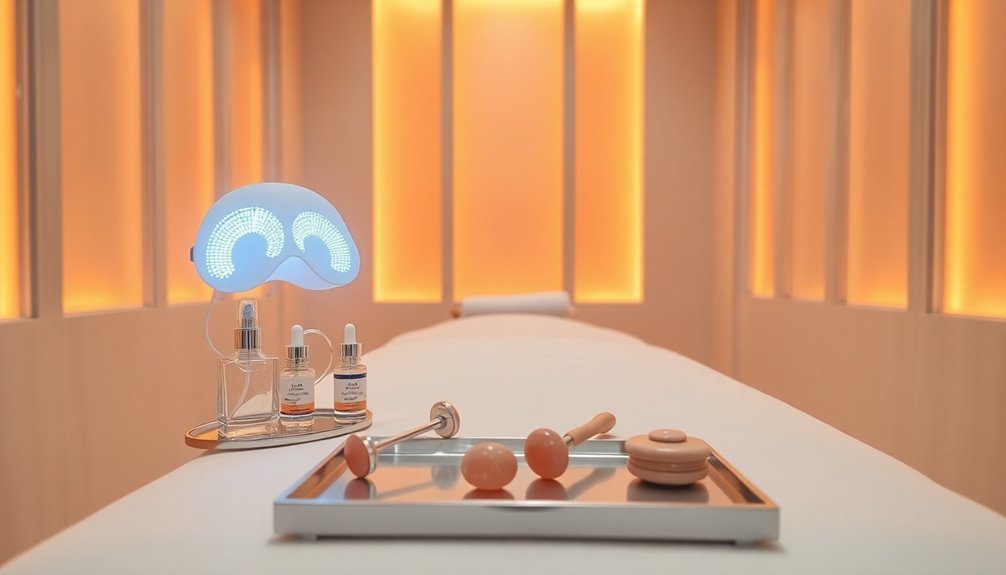
Throughout your anti-aging journey, maintaining a consistent long-term protocol serves as the cornerstone of sustainable results. Your daily routine must prioritize five essential steps: gentle cleansing, vitamin C application in the morning, retinol treatment at night, proper moisturization, and broad-spectrum sunscreen protection.
You'll need to extend your skincare beyond your face, including your neck and hands, as these areas often reveal early signs of aging. When selecting products, focus on scientifically proven ingredients like hyaluronic acid, ceramides, and retinol. If you have sensitive skin, consider plant-based alternatives like phyto-retinol.
To maximize your investment – considering Americans spend an average of $322.88 annually on skincare – make certain you're layering products correctly. Start with the lightest formulations and progress to heavier ones.
Your morning routine should include cleanser, vitamin C serum, moisturizer, and SPF 30+ sunscreen, while your evening routine should substitute vitamin C with retinol.
Advanced Anti-Aging Applications
Modern anti-aging protocols have expanded beyond traditional skincare routines to incorporate advanced therapeutic applications. You'll find cutting-edge treatments that combine targeted ingredients with light therapy and photobiomodulation for maximum effectiveness.
These integrated approaches work synergistically to stimulate collagen production, enhance cellular repair, and improve overall skin health.
The most powerful anti-aging results come from combining specific wavelengths of light with advanced skincare ingredients. When you use red light therapy at 630-660nm alongside peptides and retinoids, you'll accelerate skin rejuvenation and cellular turnover.
Near-infrared light at 830-855nm penetrates deeper into tissues, working with hyaluronic acid and antioxidants to boost hydration and protect against environmental damage.
- Use retinoids and peptides in your evening routine, followed by a 20-minute red light therapy session
- Combine hyaluronic acid with morning NIR light exposure for deep hydration
- Apply antioxidant serums before photobiomodulation treatments to enhance results
These advanced applications don't just address surface-level concerns – they work at the cellular level, stimulating mitochondrial function, enhancing ATP production, and activating the body's natural healing processes.
The key is consistency and proper integration of these therapeutic modalities into your daily routine.
Frequently Asked Questions
Can Red Light Therapy Help With Hair Loss and Scalp Conditions?
Yes, you'll find red light therapy can effectively treat hair loss and scalp conditions. It stimulates follicles, increases blood flow, and boosts hair growth, with studies showing up to 51% improvement in hair production.
Does Taking Certain Medications Interfere With Red Light Therapy Effectiveness?
Yes, certain medications can interfere with red light therapy. If you're taking immunosuppressants, corticosteroids, or photosensitizing drugs, you'll need to consult your healthcare provider before starting red light therapy treatments.
Is Red Light Therapy Safe During Pregnancy or While Breastfeeding?
You'll need to be cautious with red light therapy during pregnancy and breastfeeding. Don't use it on your abdomen while pregnant, and always wear eye protection. Consult your healthcare provider before starting treatment.
Can Children or Teenagers Safely Undergo Red Light Therapy Treatments?
Yes, children and teenagers can safely use red light therapy under proper supervision. You'll need to monitor treatment duration, guarantee they follow safety guidelines, and consult healthcare providers, especially for those with specific medical conditions.
Will Red Light Therapy Affect Permanent Makeup or Microbladed Eyebrows?
You don't need to worry about your permanent makeup or microbladed eyebrows with red light therapy. It's safe and won't damage or fade your cosmetic tattoos since it uses gentle, non-UV wavelengths.
In Summary
Red light therapy's scientific benefits are now within your reach. You'll see maximum results by following the daily protocol and avoiding common mistakes we've discussed. Remember to track your progress, stay consistent with treatments, and maintain the right wavelengths for your skin's needs. With proper cellular repair activation and enhanced collagen production, you're on your way to achieving lasting anti-aging results through this breakthrough treatment approach.
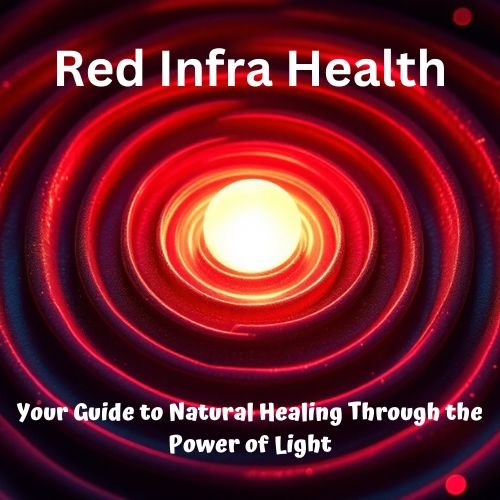


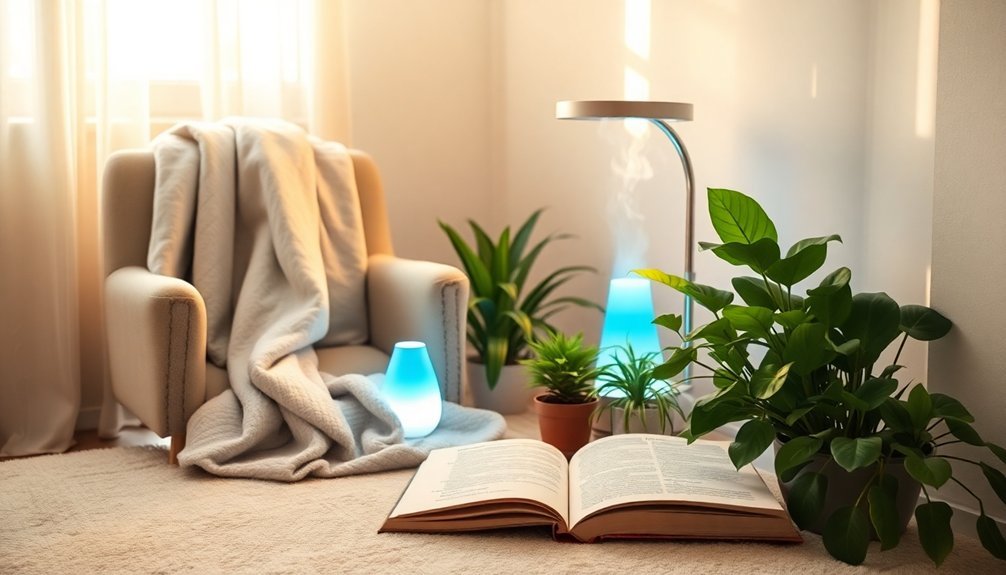

Leave a Reply